Bringing A Puppy Home? Here’s Everything You’ll Wish You Knew First
When you purchase through links on our site, we may earn a commission. Here’s how it works.
Bringing home a puppy is pure magic. Those tiny paws, wobbly steps, and wide-eyed stares can steal your heart in a heartbeat, but that adorable fluffball also brings a whole lot of responsibility. From picking the perfect pup to getting your home puppy-ready, there’s plenty to think about before the tail-wagging truly begins.
Table of Contents
Life with a puppy is messy, sweet, and full of surprises. You’ll both learn as you go, but a little preparation can make all the difference. From blocking off chewable corners to figuring out the best food for tiny tummies, every detail helps. And the more ready you are, the more you’ll enjoy every happy bark, silly zoomie, and snuggly nap that comes your way.
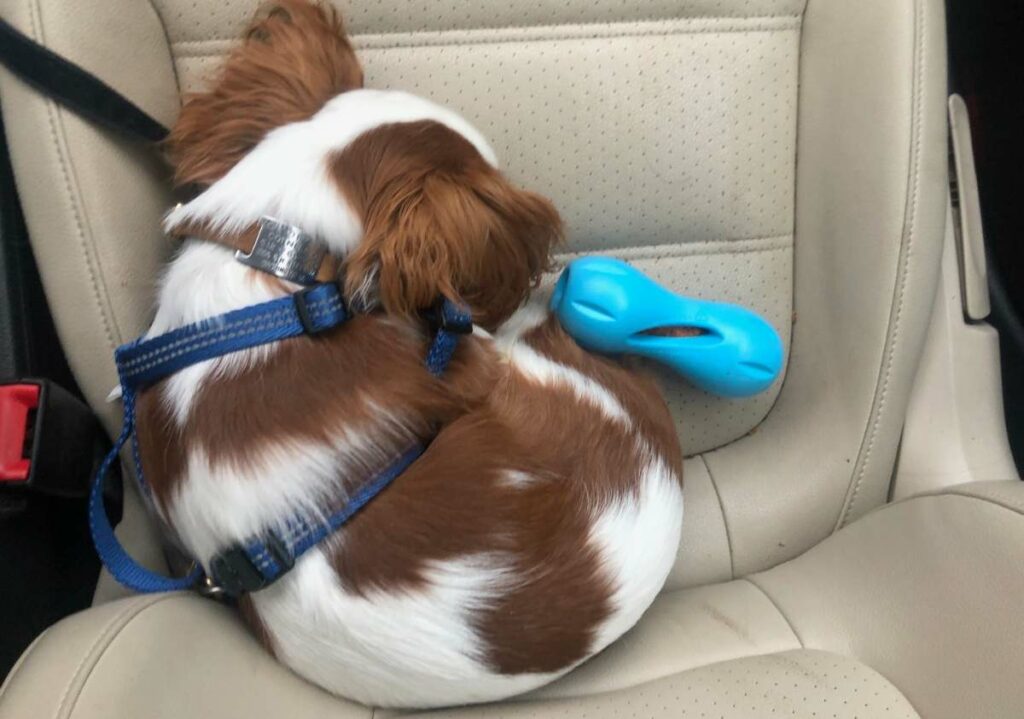
New Dog, New Responsibilities—Is Your Family Prepared?
Before you fall for those big eyes and wiggly tails, it’s important to ask: Is your home truly ready for a four-legged tornado of love and chaos?
Bringing a puppy into your life is exciting, but it’s also a big commitment that affects everyone under your roof, whether they walk on two legs or four. Adding a new puppy to a family that’s not completely welcoming can be difficult for family members and the puppy. As part of your preparation, try our checklist to see if you are ready to adopt a dog.
Before the Puppy Paws Hit the Floor: 5 Things to Consider
Bringing home a puppy is a big step; a little planning goes a long way. Before the cuteness sweeps you away, take a moment to think through the realities of puppy parenthood. Here are five things to consider before the paws of your new furry best friend hit the floor.
1. Who’s On Board?
Start with the humans. Is everyone in the household excited about the idea of a new pup, or at least on the same page? Adding a dog changes the daily routine, whether you live with a spouse, kids, or roommates. Who’s walking the dog before work? Who’s okay with a little fur on the couch (and possibly the bed)? Who’s watching the puppy when you’re not home? Clear expectations now can prevent a lot of future frustration.
2. Got Kids?
Puppies and children can be a great match, but it takes some guidance. Little ones will need help learning to handle the puppy gently, understand dog body language, and avoid turning tail-wagging time into too much roughhousing. Expect to supervise interactions until your pup is older and your kids are confident and calm around animals.
3. Space Check: Is Your Home Dog-Friendly?
You don’t need a mansion with a giant yard, but you do need to think about space. Do you have a safe area for potty training? A quiet spot for a crate or bed? If you live in an apartment, are pets allowed? Is there easy access to outdoor space for walks and bathroom breaks? Every home can be a dog home with a little planning, but tight spaces and tight schedules may need extra prep.
4. Budget Reality
Puppies don’t just steal socks. They also nibble away at your budget. Beyond adoption fees, you’ll need to budget for food, toys, vet visits, grooming, training, and surprise chewed-up phone chargers. Even small breeds come with significant expenses.
5. Time, Patience, and a Sense of Humor
Puppies are adorable little disasters. They require time, training, supervision, and a whole lot of patience. Ask yourself: Can you (or someone in your home) be around often enough during the early weeks to handle house training, bonding, and regular meals? If not, is there a plan in place, like a pet sitter, family member, or flexible work schedule?
The bottom line: Puppies bring love, fun, and unforgettable moments, but they also need structure, support, and a fully onboard household. A little honest reflection now will help set you and your future furball up for success.
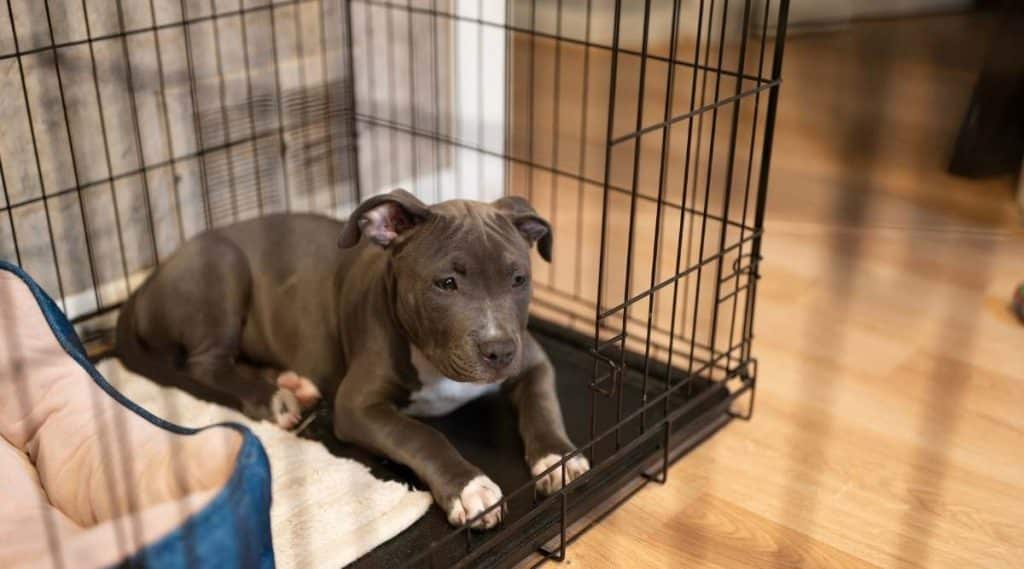
Who’s Doing What? Understanding the Real-Life Responsibilities of Dog Ownership
So, is your family all in on getting a puppy? Fantastic! Now comes the slightly less adorable part: figuring out who’s doing what when that bundle of fur arrives and starts turning your routine upside down.
Owning a dog, especially a puppy, isn’t all tail wags and squeaky toys. Behind every cute Instagram photo is someone holding a poop bag and wondering how their life got here. Puppies need to be fed (multiple times a day), walked (rain or shine), and cleaned up after (surprisingly often). Add in basic training, housebreaking, and a whole lot of playtime, and suddenly your calendar starts looking… very dog-focused.
To keep things running smoothly and avoid one person turning into the “designated dog parent” by default, assign tasks early on. Set up a rotating schedule for the not-so-glamorous stuff like potty breaks, feeding, walking, and cleanup. Trust us, no one wants to be on 6 a.m. pee duty every single morning. Sharing the load means fewer complaints and a happier household.
Of course, it’s not all chores. There’s also the fun stuff, like who gets to choose the toys, give the bubble baths, or be the official bedtime snuggler. Let younger kids participate in the exciting responsibilities (with supervision), like picking out the collar or helping with treat time. When the whole family gets involved, everyone builds a stronger bond, not just with the pup but with each other.
Pro Tips:
- Keep tasks flexible based on who’s home and available.
- Rotate the “less fun” jobs (hello, poop patrol!) to prevent burnout.
- Let kids earn extra privileges by helping with care, like choosing the next toy or treat.
- Add stickers, magnets, or dry-erase markers if you post this on the fridge!
In the end, raising a puppy is a team effort. Some days will be messy. Some will be hilarious. But when everyone pitches in, those early weeks become a lifetime of tail wags and loyal companionship. Learn more about how to bond with your new pet.
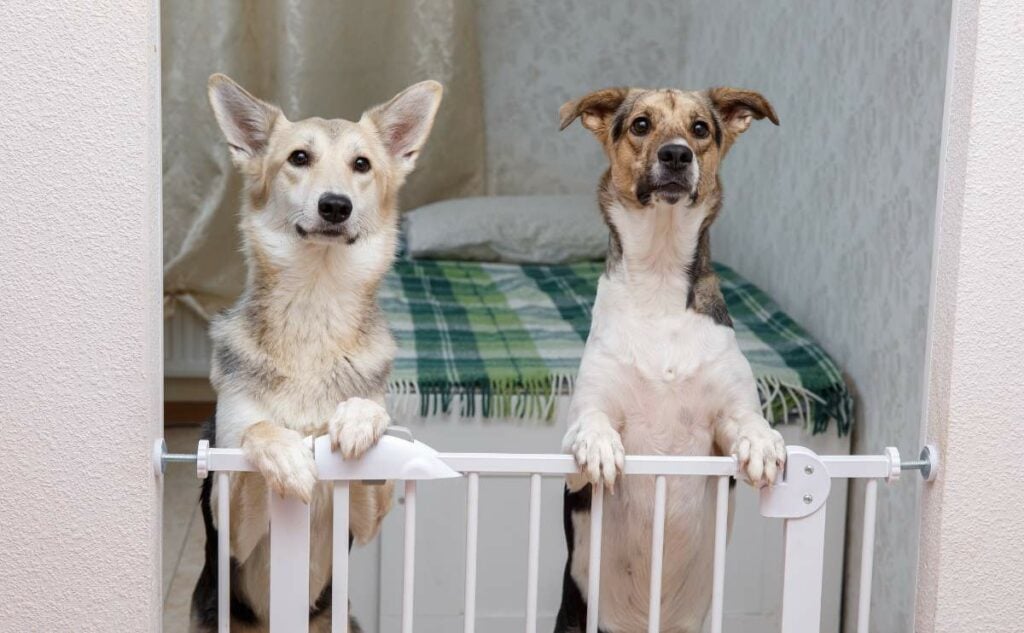
How to Puppy-Proof Your Home (So Your Stuff and Your Pup Survives)
Bringing a puppy into your home is a little like inviting a tiny, furry tornado with teeth. Adorable? Yes. Destructive? Also, yes, if you’re not prepared.
Most puppies explore the world mouth-first, which means anything within reach is fair game: shoes, phone chargers, chair legs, underwear (yes, they will find it), and pretty much anything that can be chewed, swallowed, or dragged around like a trophy.
While it might be funny the first time, the risk to your wallet and your puppy’s health is no joke. Vet bills for intestinal blockages from swallowed socks or squeaky toy parts can run into the thousands. We share some helpful tips below.
Start at Ground Level
Get down on your puppy’s level, literally. Crawl around a bit (yes, really) and look for tempting hazards. If it dangles, drags, or shines, they will try to bite it. Pick up anything small enough to be swallowed: hair ties, buttons, coins, LEGOs (especially LEGOs).
Block Off No-Go Zones
Use baby or dog gates to keep puppies out of certain rooms or up/downstairs. Think of it as creating a “puppy-safe zone” where they can explore without constant supervision. The kitchen, bathroom, and laundry room often have too many hazards to leave unsupervised.
Hide the Wires
Cords and cables look suspiciously like chew toys to a teething pup. Bundle them, hide them behind furniture, or use cord protectors. You can also spray them with a bitter apple deterrent but don’t forget which ones you’ve treated when you plug them into your phone.
Protect Your Furniture (and Sanity)
Table legs, chair rungs, and couch corners are all fair game. If you don’t want it gnawed on, consider using furniture-safe chew deterrent sprays or keep those areas blocked off. Provide plenty of acceptable alternatives, like tough chew toys and teething rings, to redirect the chomping.
Think Like a Puppy Burglar
Trash cans? Snack jackpot. Toilet paper? Instant party. Houseplants? Possibly a toxic salad bar. Secure lids, stash bathroom supplies in cabinets and double-check your plants for toxicity (puppies love digging and nibbling in pots).
Electrical & Safety Basics
- Use outlet covers for any low plugs.
- Keep cleaning supplies and medications locked away.
- Avoid looped cords from blinds or curtains. They can pose strangulation risks.
- Don’t leave bags (especially purses and backpacks) on the floor. Gum, mints, and snacks are often dangerous for dogs due to containing xylitol, an artificial sweetener that is toxic to dogs.
Puppy-proofing takes a bit of time, but it’s so worth it. Not only will you protect your favorite things, but you’ll also keep your curious pup safe as they learn the ropes of their new home. And just like baby-proofing, it doesn’t last forever. Your shoes (and sanity) will thank you later.
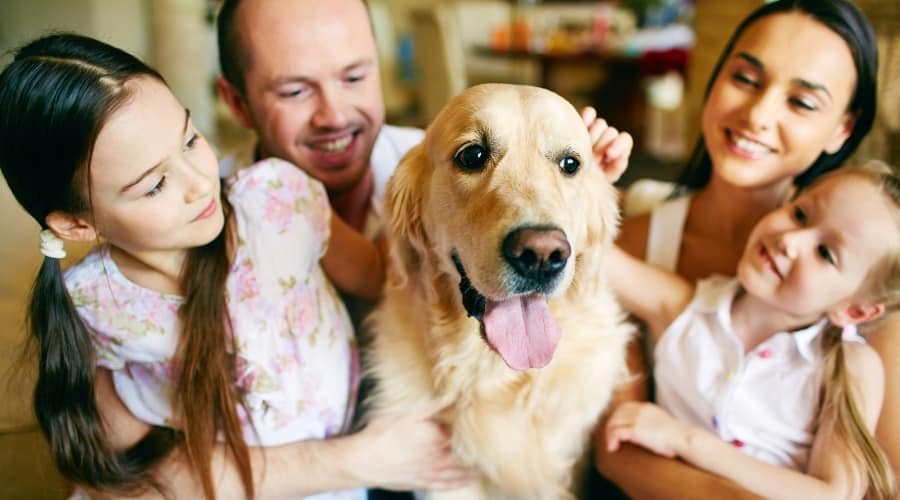
Kids + Puppies = A Learning Adventure
Bringing a puppy home is a magical experience for the whole family, especially kids. But with that excitement comes a learning curve.
Teaching children how to interact with their furry siblings safely is just as important as puppy-proofing the house. You can learn more about how to introduce your kids to a new puppy in our detailed guide on the subject.
Gentle Hands, Happy Pups
Toddlers and young children are naturally curious, but they don’t always know their own strengths. It’s crucial to teach kids that puppies are not stuffed animals. They’re living, breathing, feeling beings.
Explain that tugging ears, squeezing too hard, or climbing on the puppy can hurt or scare them. Demonstrating how to gently pet the puppy, stroke its back, or give it space can go a long way in building a lifelong bond.
Pro Tip: Use stuffed animals for practice before the puppy arrives. Show how to pet gently, talk softly, and interact calmly.
Bite-Sized Boundaries
Those tiny puppy teeth are sharper than they look. Young children should be reminded to keep their fingers away from the puppy’s mouth and never to play tug-of-war with bare hands. Instead, teach them the “swap trick”: if the puppy starts to nibble, offer a chew toy instead.
Activity Idea: Turn it into a game. Have your child be the “toy detective,” always ready to hand over a plush chew when the puppy gets mouthy.
Naptime Is Sacred
It may be tempting for a child to cuddle or wake a sleeping puppy, but rest is essential for a growing dog. Start early by teaching that when the puppy is sleeping, it’s off-limits, no poking, prodding, or loud surprises. Just like humans, puppies can get startled when abruptly woken, and that startle can sometimes result in an unintentional snap.
Phrase to Teach Kids: “Let sleeping pups lie.”
Must-Have Gear for Your New Pup
Now it’s time to shop for those must-have items for your new family member. Most people tend to overshop for their new puppy, and there are only a few items that you absolutely need.
- A collar and leash with an up-to-date ID tag
- Stainless steel or another good dog bowl
- A crate that is just big enough for your puppy to stand in; you can add a divider for larger crates to make them smaller. This prevents the need to buy more than one during your dog’s lifetime (crates give your puppy somewhere safe to sleep and assist with housebreaking and training) — learn more about crate training
- Bedding for the crate, if you decide to use one (a folded blanket or a fleece crate liner)
- A comfortable dog bed
- Carpet cleaner (there will be accidents)
- An entertaining teething toy (the Puppy Kong is the most recommended toy)
- A comforting item (A soft toy that mimics a heartbeat or a t-shirt from the puppy’s mother or its siblings. Be sure it doesn’t get ripped or ingested.)
- A bag of puppy food
- Pet insurance can help you prepare for major medical bills
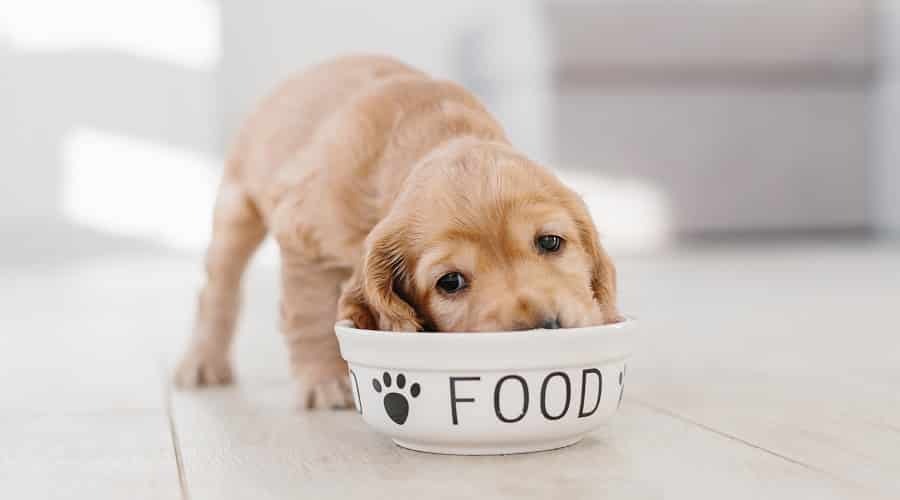
What’s for Dinner? Finding the Right Puppy Food
Choosing food for your new puppy can feel like wandering down the world’s longest pet food aisle, with 400 bags, 300 opinions, and one very hungry little pup. It’s easy to feel overwhelmed, but the good news is that with a little know-how, you can pick a diet that supports your puppy’s growth, health, and tail-wagging energy.
Why Puppies Need Puppy-Specific Food
Puppies aren’t just smaller versions of adult dogs. They’re growing fast, building muscles, developing bones, and burning calories like tiny athletes. That’s why they need formulas made specifically for puppies, which are higher in calories, protein, fat, and certain nutrients (like calcium and DHA for brain development). Adult dog food simply doesn’t meet those needs and could lead to nutritional imbalances.
Puppies should stay on puppy food until they’re around 12 months old (a bit longer for large breeds). If you’re unsure when to switch to adult food, your vet can help guide the timing.
Ingredients to Look For
When reading dog food labels, look for:
- High-quality animal protein as the first ingredient (like chicken, beef, turkey, or salmon)
- Healthy fats (such as chicken fat or fish oil) to support energy and skin/coat health
- Whole grains or complex carbohydrates, like brown rice, oats, or sweet potatoes for digestible energy
- Omega-3 fatty acids (especially DHA) to support brain and vision development
- Calcium and phosphorus in balanced ratios to promote healthy bones and teeth
- No artificial colors, preservatives, or meat by-product meals
- Avoid foods that rely heavily on fillers like corn, wheat, or soy, especially if they appear high on the ingredient list. These aren’t necessarily harmful but may be less nutritious and digestible.
Ask Around (and Read the Label)
Most breeders, rescues, and shelters will send your puppy home with a recommendation, or at least let you know what food they’ve been feeding. That’s your starting point. Even if you plan to switch to another brand later, it’s important to transition slowly to avoid upsetting your puppy’s stomach.
Transition Tip: Mix the old and new foods over 7–10 days:
- Days 1–2: 75% old food, 25% new food
- Days 3–4: 50/50
- Days 5–6: 25% old, 75% new
- Day 7+: 100% new food
Dry, Wet, or Fresh?
- Dry kibble is the most common, convenient, and budget-friendly option. There are plenty of varieties, including dehydrated and air-dried kibble.
- Wet food can be more palatable for picky eaters, but it is more expensive and less shelf-stable. Most dogs eat a mix of wet and dry food.
- Fresh-prepared diets are trendy, but they require careful balancing and storage and are best done under a vet or pet nutritionist’s guidance. You may want to consider a dog food delivery service if you want fresh or human-grade meals for your pup. These are prepared fresh and then shipped directly to your door.
In the end, the best puppy food is one that meets nutritional standards, fits your budget, agrees with your pup’s tummy, and gets the tail going at mealtime. Don’t be afraid to ask your vet for guidance; after all, they’ve seen it all (including when your puppy ate an entire sock).
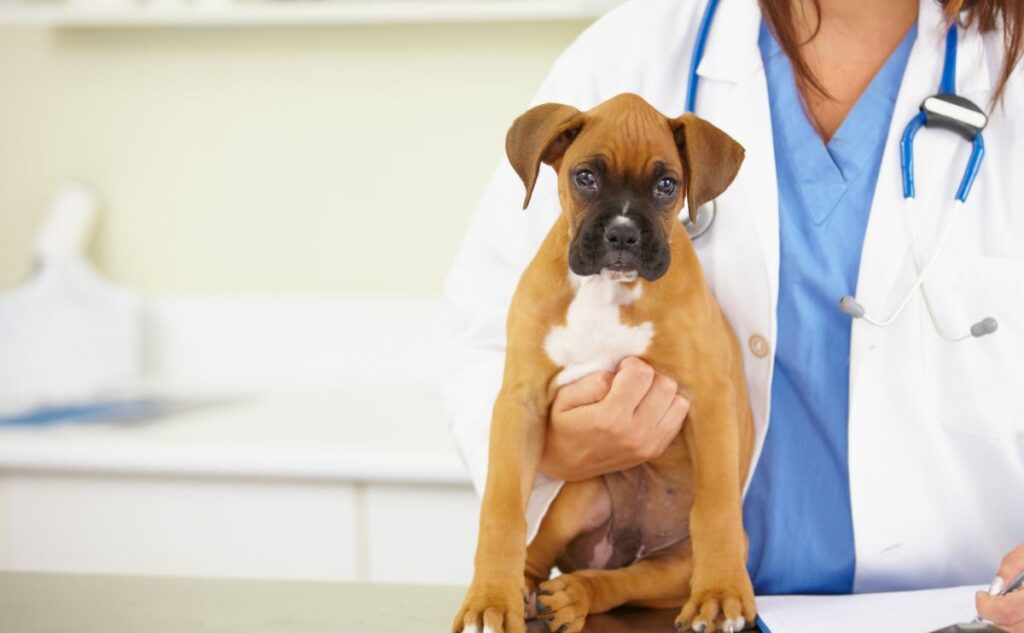
Selecting a Vet: Your Puppy’s Health Partner
It might seem a little premature to vet-shop before your puppy even arrives, but finding the right veterinarian before an emergency hits can save you a lot of stress (and late-night panic Googling). Your puppy will need checkups, vaccinations, and probably a few “what is that in their mouth?” visits, so it’s smart to have a trusted vet lined up early.
Start by asking people you trust, like friends, breeders, shelter staff, or rescue volunteers, for recommendations. Then, don’t hesitate to visit a few clinics in person. A clean space, friendly staff, and a vet who takes the time to answer your questions can make all the difference in how supported you feel as a new dog parent.
Your vet isn’t just there for shots and emergencies. They’ll help you navigate everything from food choices and flea prevention to spaying/neutering and behavior questions. Remember, some dogs seem to have a talent for trouble, so you may end up seeing your vet more often than expected. Find one you feel good about now, and in the future, you (and your puppy’s stomach) will thank you.
Checklist: What to Look For in a Great Vet
- Clean, welcoming office
- Friendly, knowledgeable staff
- Clear communication and willingness to answer questions
- Experience with your puppy’s breed or size
- Convenient hours and location
- Emergency or after-hours care options
- Reasonable pricing or wellness plans
Pet Insurance: A Smart Move During Puppyhood
As a puppy, your young dog has probably not shown any significant health concerns. Since pet insurance companies do not cover pre-existing conditions, the younger your dog is when you sign up, the better coverage you will likely receive throughout their lifetime, so long as your policy stays active. Further, pet insurance can help support you financially during the unpredictable puppy years when dogs are more likely to chew on things they shouldn’t and run into less predictable situations. Check out our pet insurance 101 guide to learn more and determine whether pet insurance or a wellness plan is worth it for your puppy.
Vaccination Planning: Stay Ahead of Schedule
Find out from your shelter, breeder, or rescue group when your puppy is due for his next round of puppy shots, and set up an appointment with your new vet to get these shots done on time. It’s crucial for your puppy’s health that he stays current on vaccinations.
Puppy Vaccination Schedule: A Week-by-Week Timeline
Vaccinating your puppy on schedule is one of the best ways to protect them from serious, potentially life-threatening diseases. Here’s a detailed breakdown of what vaccines your puppy will need when to get them, and what each one helps prevent.
6–8 Weeks Old
- Distemper – A contagious virus that affects the respiratory, gastrointestinal, and nervous systems.
- Parvovirus (Parvo) – A highly contagious and deadly virus that attacks the intestines.
- Bordetella (optional) – Also known as kennel cough, this vaccine is often required for daycare, grooming, or boarding.
Why now? This is usually your puppy’s first vet visit. Vaccines given now begin to build immunity against highly contagious diseases. Bordetella is optional at this stage, but it is recommended if your pup is in close contact with other dogs.
10–12 Weeks Old
- DHPP Combination Vaccine
- Distemper
- Hepatitis (Adenovirus) – Affects the liver and can lead to severe illness.
- Parainfluenza – One of the causes of kennel cough.
- Parvovirus
- Leptospirosis (optional but often recommended) – A bacterial infection spread by wildlife urine that can be transmitted to humans.
Why now? Your puppy’s immune system is still developing, and this booster strengthens protection from earlier vaccines. Leptospirosis is especially important if your dog will be outdoors a lot, near standing water, or in rural areas.
16–18 Weeks Old
- DHPP Booster – Final dose in the puppy series.
- Rabies – Legally required in most places; protects against a fatal virus transmissible to humans.
Why now? By this age, your puppy’s immune system is mature enough to respond fully to the rabies vaccine, which is often required for licensing and travel. The final DHPP booster helps ensure long-term immunity.
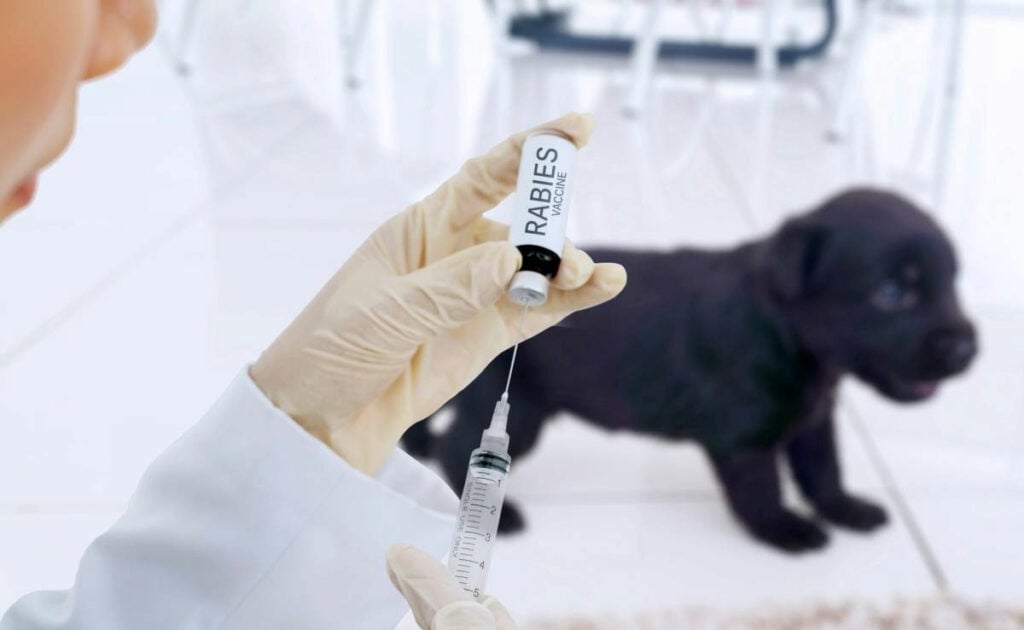
Key Diseases Prevented by Timely Shots
The two diseases that are at the top of the list for puppy vaccines are canine distemper and canine parvovirus. Both are potentially fatal diseases for dogs, especially puppies, but proper vaccinations can easily prevent them. Remember that it’s always necessary to get follow-up booster shots for your pet’s vaccines.
Heartworm: Prevention is Better than a Cure
Like vaccines, heartworm prevention is another must-have for all puppies. Heartworm disease is one of the most life-threatening diseases for dogs, and all it takes to contract it is a bite from an infected mosquito. Ask the previous owner, breeder, or animal shelter about what heartworm medication your puppy has been taking, and when he needs the next dose.
There are a wide variety of different types of heartworm prevention available — a monthly tablet, a topical solution, and an injection that’s administered every six months. Ask your vet at your first puppy visit what she recommends using as a regular heartworm preventative for your dog. The cost is around $10 or less per month.
Spaying or Neutering: What You Need to Know
Deciding whether to spay or neuter your puppy might not feel urgent right away, but it’s a choice that plays a significant role in your dog’s long-term health, behavior, and overall well-being. Unless you have a show-quality purebred with a thoughtful breeding plan (and the time, money, and expertise that comes with it), most vets and animal welfare experts recommend getting your pup fixed.
Why? For starters, spaying or neutering helps prevent unwanted litters and reduces the number of homeless pets, a serious issue in shelters nationwide. But beyond that, the benefits go far beyond population control.
Health-wise, spaying females helps prevent uterine infections and dramatically reduces the risk of breast cancer, especially if done before their first heat. Neutering males eliminates the risk of testicular cancer and can help with prostate issues later in life. According to the American Veterinary Medical Association (AVMA), these procedures can extend your dog’s life expectancy and improve their overall health outcomes.
Behaviorally, fixing your dog may help curb roaming, urine marking, and certain aggressive or dominant behaviors, though it’s not a magic fix for every issue. Studies show neutering helps reduce hormone-driven behaviors, especially in males, and may make training a little smoother (and your furniture a little safer).
The timing of the procedure can vary by breed and size. Some large-breed dogs may benefit from waiting longer to avoid potential orthopedic issues. A 2020 study published in Frontiers in Veterinary Science suggests that for certain breeds, delaying surgery until after one year may lower the risk of joint disorders. That said, your vet is the best person to help you weigh the risks and benefits based on your dog’s unique needs.
Welcome Waggin’: Your Puppy’s First Day at Home
The big day is finally here! Your puppy is officially part of the family! It’s hard not to squeal with excitement (or cry happy tears), but remember that your puppy has just left behind everything familiar, and this new world is a lot to take in. The goal for day one? Keep things calm, cozy, and comforting for both of you.
Keep It Chill (Yes, Even If You’re Freaking Out With Joy)
As tempting as it is to throw a welcome party, your puppy will appreciate a soft landing. Keep the house quiet and low-key for at least the first day or two. If you have kids, encourage them to speak gently and give the puppy space to sniff and explore at their own pace. Avoid sudden noises, too much picking up, or overwhelming attention right away. Your pup is still figuring out where they are (and why everything smells weird).
Set Up a Puppy “Landing Zone”
Before your pup sets paw inside, have a designated area set up, ideally a quiet space with a comfy crate, a food and water bowl, and a soft blanket that smells like you (or the shelter/breeder, if you have one). Toss in a chew toy or two and leave the crate door open so they can explore it freely. This little den becomes their safe spot to rest, retreat, and reset.
It’s also smart to limit access to the rest of the house for now. Use baby gates or closed doors to create boundaries. This makes things less overwhelming and much easier for potty training.
Introductions: Slow and Supervised
If you have other pets, keep those first meetings short, sweet, and fully supervised. Let them sniff through a baby gate or on a leash, and give your resident pet time to adjust. Don’t expect instant best friends, think more like cautious coworkers slowly warming up over snacks.
The same goes for people! While socialization is important, keep new human introductions calm and minimal for the first few days. Your puppy needs a bit of time to feel safe and grounded before being passed around like a stuffed animal.
Pro Tip: The first day is all about comfort, connection, and calm. Sit on the floor, let them come to you, and offer gentle affection. Your pup doesn’t need a perfect performance. They just need to know they’re home.
Watch and Learn: Top Tips for New Puppy Parents
This video has many more tips and tricks for you to consider before, during, and after bringing a new canine addition into your home.
Potty Training: Turning Accidents Into Successes
Potty training is one of the first significant milestones in puppyhood, and yes, there will be messes. But with a little consistency and a lot of patience, your pup will catch on faster than you think.
Set a Routine
Puppies thrive on structure. Take them out:
- First thing in the morning
- After meals or playtime
- Before bed
- Every 1–2 hours during the day (yes, really!)
Pick a designated potty spot and bring them to it each time. When they go to the right place, you should celebrate like they just won a gold medal. Offer praise, treats, and a favorite toy to show they have done the right thing.
Watch for Signs
Sniffing, circling, whining, or heading to a corner are your puppy’s way of saying, “Hey, I gotta go!” Get them outside quickly, and they’ll start to connect the dots.

Accidents Happen
If they have an accident indoors, clean it up with an enzymatic cleaner to remove the scent (and the temptation to go there again). Don’t punish. It only teaches them to hide it from you. Instead, focus on catching the good behavior and reinforcing it.
With a little patience, your pup will learn where the bathroom is, and you can put the paper towels away (mostly). Potty training takes time, but it’s one of the most rewarding wins in those early weeks.
Training Basics: Teaching Your Puppy to Be Their Best Self
Training isn’t just about having a well-behaved dog—it’s about building communication, trust, and a happy relationship between you and your pup. The earlier you start, the easier it is to teach good habits (and avoid bad ones like jumping, nipping, or counter-surfing).
Start with the Essentials
Every puppy should learn a few basic commands to stay safe and polite:
- Sit – A great way to teach patience and stop jumping.
- Stay – Helps build impulse control and focus.
- Come – One of the most important for safety and recall.
- Leave it / Drop it – This is for when they find something they really shouldn’t have.
- Down – Teaches calm behavior and can replace jumping or barking.
Short, fun training sessions (just 5–10 minutes) work best. Use plenty of praise, treats, and play to reward your puppy for getting it right. Keep things upbeat. Puppies learn best when it feels like a game. Learn more in our fun video below on teaching dogs basic commands.
Consistency Is Key
Set clear rules and stick to them. If the puppy isn’t allowed on the couch one day and then snuggled there the next, they’ll be confused, and probably win that battle every time. Make sure everyone in the household is on the same page.
A little training every day goes a long way. With time, patience, and positive reinforcement, you’ll raise a dog who listens well, behaves confidently, and makes you proud everywhere you go.
Socialization Strategies: Raising a Friendly, Confident Puppy
Socialization is one of the most important things you can do for your puppy, and the earlier you start (safely), the better. A well-socialized pup grows into a confident, friendly adult dog who’s comfortable in all kinds of situations, from noisy parks to calm vet visits.
What Is Socialization Really?
It’s not just about meeting people and dogs, though that’s a big part of it. True socialization means gently introducing your puppy to all the things they’ll encounter in life: new sounds, sights, smells, surfaces, and experiences. Think: bicycles, vacuums, slippery floors, toddlers, men with beards, and dogs of all shapes and sizes.
Smart Socializing: 6 Tips for Success
- Start slow and safe. Focus on quality over quantity. Every experience should be positive, not overwhelming.
- Use treats and praise to create happy associations with new things (strangers = snacks = awesome).
- Meet a variety of people. Different ages, voices, and appearances help your puppy grow up to be people-friendly and adaptable.
- Go places. Once your vet gives the green light, take your pup to parks, pet stores, outdoor cafés, or even short car rides.
- Introduce friendly, vaccinated dogs. Set up playdates with dogs you trust. Well-behaved older dogs can teach your puppy the social ropes.
- Don’t forget sounds and surfaces. Let your puppy walk on grass, tile, carpet, or concrete. Play recordings of fireworks, thunderstorms, or babies crying at low volumes to get them used to everyday noises.
Watch Their Body Language
Keep a close eye on your pup’s signals. If they seem unsure, don’t force it. Let them observe from a safe distance and reward calm behavior. Pushing too hard, too fast, can create fear instead of confidence.
Socialization works best in small, frequent doses. With just a few minutes a day, you can help shape a puppy that grows into the dog everyone loves to be around, calm in crowds, relaxed at the vet, and polite with people and pets alike. And if you need additional help with your pup, you might consider online dog training at home.
From Puppy Breath to Best Friend: You’ve Got This!
Welcoming a new puppy into your life is one part joy, one part chaos, and all heart. From picking the perfect food and vet to surviving teething, potty training, and chewed-up socks, you’re laying the groundwork for a lifelong friendship. It’s not always smooth, but every tail wag, cuddle, and silly moment makes it so worth it.
As your puppy grows, so does your role as their teacher, protector, and favorite human. Be patient, be consistent, and above all, be present. Being a responsible pet owner means more than love; it means keeping up with vaccinations, feeding a healthy diet, having regular vet visits, and giving them the training and attention they need to thrive.
So go ahead, soak up those snuggles, snap those “first everything” photos, and give your pup the best start possible. You’re not just raising a dog. You’re raising your new best friend. We would love to hear about your new puppy adventures and advice in our comments.
Why Trust Canine Journal?
Michelle has been a dog owner her entire life and is currently a co-parent to two rescue pups, Barley and Lily. Michelle specializes in pet insurance for dogs. She’s part of a team of dog specialists at Canine Journal who have over a decade of experience researching, testing, and writing about everything you need to know to keep your pup healthy and happy.



